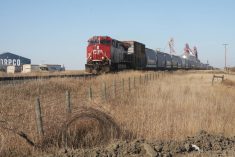Albertans dealt with fire bans last week as we brace for what could be the seventh year of below average water supplies in the last decade. Soil moisture is already below average, and below average snow pack means river flows could be down across much of Alberta in 2010.
Rainfall forecasts indicate it also will be a drier than average spring. These trends are consistent with predictions about the impacts of climate change on Alberta’s water supply by David Schindler and other reputable scientists.
Read Also

Agriculture needs to prepare for government spending cuts
As government makes necessary cuts to spending, what can be reduced or restructured in the budgets for agriculture?
At the same time, projections suggest that increasing levels of industrial, agricultural and urban development will reduce dramatically the quality and quantity of water in Alberta’s watersheds.
The amount of Alberta’s forests that have been harvested will increase from approximately 3.95 million acres since the 1950s to more than 24.7 million acres by 2105.
The total footprint of the energy sector will more than double to 3.46 million acres by 2105, likely amplifying impacts on water and watershed functioning.
The South Saskatchewan watershed, which embraces most of southern Alberta, will be the hardest hit, though several other watersheds including the North Saskatchewan and Athabasca watersheds will also feel the heat.
Although the potential impacts of climate change and increasing levels of development seem frightening, we can do more than wring our hands and pray for rain. A large part of the solution Alberta must embrace involves protecting our watersheds from overdevelopment.
Making the Connection: Water and Land in Alberta, a new report by Water Matters, concludes that the Alberta government must protect watersheds if we are to prevent a water crisis in Alberta in the coming decades.
This is the easiest, most effective and least costly strategy to maintain healthy ecosystems and the benefits they provide, including clean, abundant drinking water, fisheries and water for agriculture and other industrial uses. The best part? It will also save taxpayers billions of dollars over the long term.
Alberta’s headwaters, forests, wetlands, riparian areas and groundwater recharge zones provide Albertans with billions of dollars of ecosystem goods and services every year.
Intact forests, for instance, provide higher water quality, a more natural flow regime, and healthier aquatic ecosystems. Wetlands are another great example of a watershed component that provides valuable goods and services.
In an era of cost-cutting, the Alberta government can actually save money over the long term by investing in maintaining and restoring healthy watersheds rather than multimillion-dollar infrastructure costs. New York City politicians, for instance, saved taxpayers $5 billion by protecting the Catskills-Delaware watershed rather than building two new water filtration plants.
These findings come on the heels of provincial budget cuts that could cripple our ability to responsibly manage Alberta’s water and other natural resources. Sustainable Resource Development’s budget dropped by $42 million and Alberta Environment saw a budget cut of approximately $16 million, which means less water monitoring in some areas.
With little money to spend on water monitoring and infrastructure upgrades, the government needs to emphasize watershed protection in the South Saskatchewan and Lower Athabasca regional plans to safeguard the health of our watersheds in Alberta.
This includes adopting indicators geared to watershed protection and implementing thresholds for road density and the amount of land that remains intact.
At the provincial level, the government should develop an effective framework of source water protection and adopt market-based instruments designed to help reach objectives set for watershed health.
















